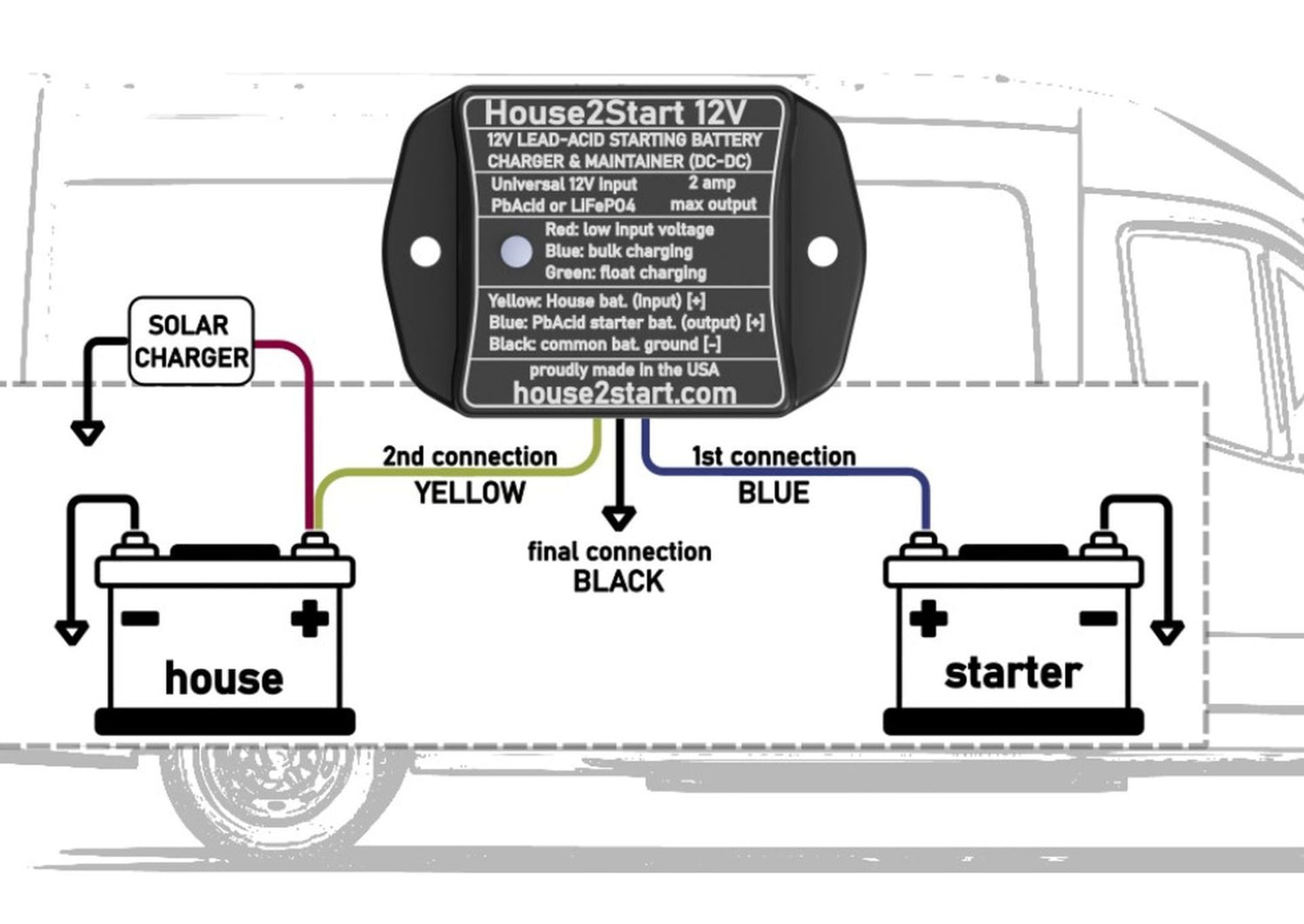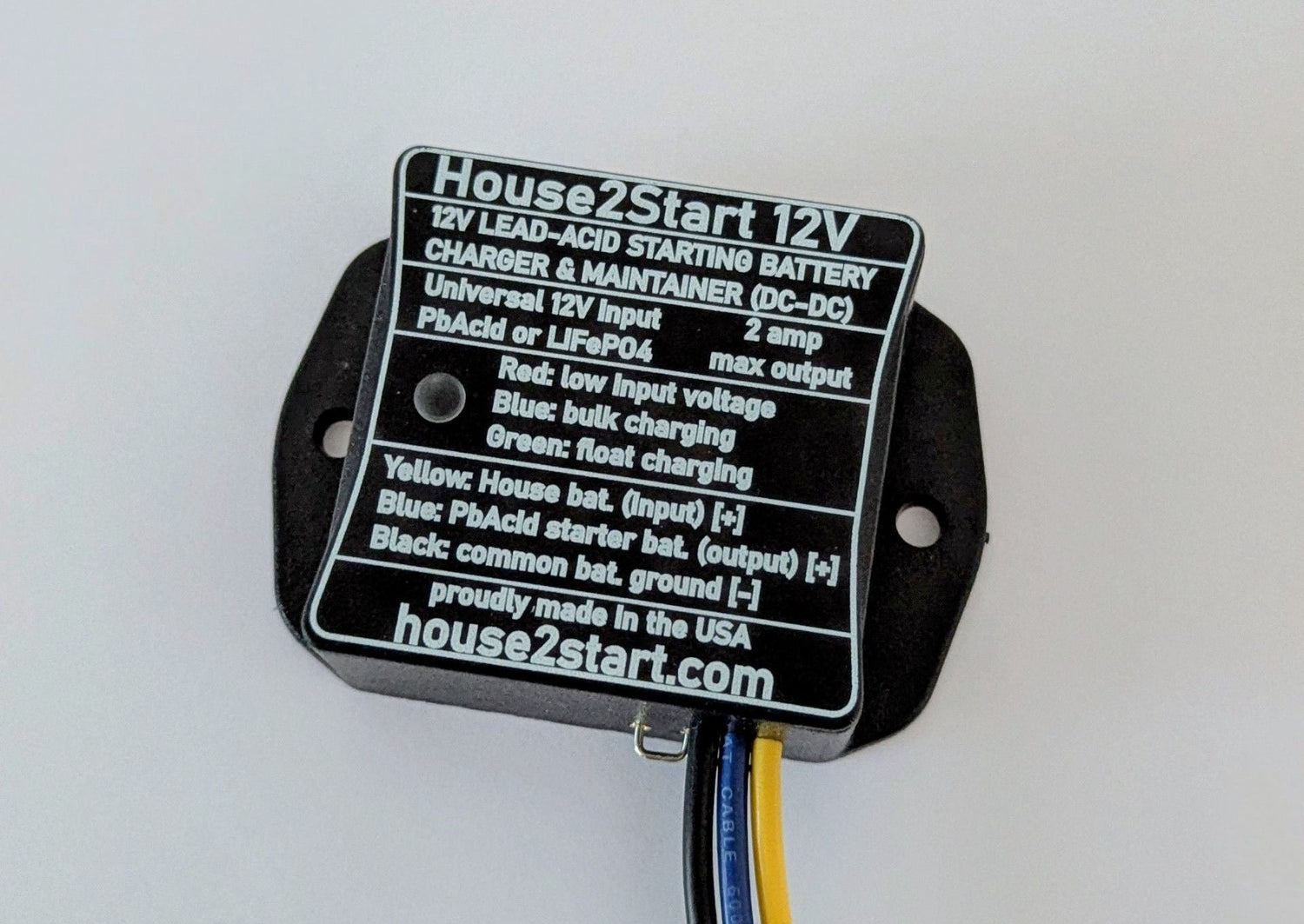House2Start Installation Guide
Where do I put House2Start in my RV?
- Installing House2Start near the batteries or existing battery charger devices can reduce or eliminate the need run new wires.
- Many RVs have a device to allow the alternator to charge the house battery. This is a great place to install House2Start. There are many different manufacturers and device names depending on the supplier and underlying technology: battery combiner, solenoid, isolator, VCR, or DC-DC charger. These devices are connected to both house and starter batteries by thick battery cables.
- House2Start can often be installed directly onto the mounting posts or terminals of these devices, simplifying the connections.
Many RVs have charging devices already connected to the RV house & starter batteries-- convenient for installing HouseStart.
-

Battery Solenoid
-

Battery Isolator
-

Mastervolt Chargemate
-

DC-DC Charger
If your RV has one of these charging devices, House2Start can usually be installed directly onto the device power lugs that are connected to the house and starter batteries. House2Start's pre-attached 18" yellow/blue/black wires further simply the installation to these devices.
Determine the house and starter battery connections on the device. Use a multimeter to measure the voltage of each battery bank, at the battery terminals, and compare to measurements taken at the device connections. Never rely solely on cable labels, device labels, or manufacturer schematics, always verify with a multimeter.
RVs with Mastervolt Chargemate
The Mastervolt Chargemate is a current limiting battery combiner, installed in most 2020+ Winnebago Navion/View/Era (Mercedes chassis) motorhomes. The Mastervolt is under the passenger seat and is a convenient location to install House2Start.
If your RV has a Mastervolt chargemate, be sure to use House2Start Gen2b charger, and install the included diode on the blue wire.
-

When installing House2Start with a Mastervolt an external diode between House2Start and Mastervolt is required. The external diode is included with every House2Start module, and is only required when installing to a Mastervolt Chargemate.
-

The Mastervolt Chargemate is located under the passenger seat on 2020+ Winnebago Navion and View motorhomes.
DC-DC Chargers
DC-DC chargers are commonly used in RVs and van conversions to charge the house battery from the vehicle’s alternator while driving. These chargers should only operate when the engine is running—otherwise, they can inadvertently discharge the starter battery. Most DC-DC chargers include a control, enable, or trigger terminal to activate the unit when the engine is running. If your DC-DC is already using the control terminal then nothing else is required.
Some models also feature a voltage-sensing algorithm that monitors starter battery voltage to detect if the engine is running for enabling/disabling the DC-DC charger. The feature is intended to simplify the DC-DC charger installation, eliminating the need to wire the control (enable) terminal.
However, House2Start—or any charger connected to the starter battery—can interfere with this algorithm and cause the DC-DC charger to turn on when the engine is off. The simplest solution is to disable the voltage-sensing algorithm and use the wired control terminal. Refer to your DC-DC charger’s manual for wiring guidance. If you need help configuring a specific charger, please contact us.
No existing alternator-to-house charging device and dual alternators

For RV without an existing charging device connected to both batteries, it may be necessary to run additional wire to install House2Start.
Mount House2Start near the house or starter battery and then extend a wire to the other battery. The manual provides requirements for yellow wire gauge & length. It is suggested to follow similar rules for the blue wire.
Be sure to fuse any wire extended beyond 18". Install the fuse as close to the battery (house or stater) as practical.

Which Jumper Setting should I Use?
Two external jumpers configure the ON (rising) and OFF (falling) voltages for the House2Start charger.
The on/off voltages increase A to D. The voltage values are given in the adjacent chart. The chart is read left to right. As an example, with Jumper Setting A:
the charger turns on when the house voltage (yellow-wire) rising above 12.5V and stays on until the house voltage (yellow-wire) falls below 12.2V. At the off voltage, or low-voltage cutoff, if house battery is lead acid chemistry, the battery will have ~50% remaining capacity, and a LiFePO4 battery less than 5%.
For RVs with AGM house battery, jumper B is suggested.
For RVs with LiFePO4 house battery, jumper C is suggested.
To increase starter battery charging priority, lower the jumper setting (i.e. C to B), so that the charger turns on earlier and stays on later.
Charge Cycle Example
The graph below illustrates the rising and falling voltage behavior for House2Start. This example shows jumper B, where the turn on (rising) voltage is 13.1V (dashed horizontal purple line) and the turn off (falling) voltage is 12.8V (dashed horizontal green line). The charger output turns on when the house voltage (yellow-wire) rises above 13.1V and stays on until the house voltage (yellow-wire) falls below 12.8V.
Before the sun rises, the starter battery (orange) is slightly discharged at 12.5V, and the AGM house (blue) also discharged at 12.6V.
- House2Start charger is OFF.
- Around 6:30AM the solar charger activates and begins to charge the house battery.
- At 7:12 AM (purple UP arrow) the house voltage (blue) rises above the 13.1V turn on threshold, which actives the H2S charger output.
- H2S is charging the starter battery, which raises the voltage (orange).
- 8:30-9AM the house solar charger is in absorption mode and the AGM house is held at 14.5V.
- 9AM house solar charger switches from absorption to float charge (13.5V).
- 10AM House2Start has reached absorption mode and the starter battery held at 14.5V.
- 10:30AM House2Start absorption mode finished and switches to float mode for starter battery (13.5V).
- 3:00PM house solar charger turns off and house battery voltage begins to decrease.
- 3:36PM (green down arrow) house battery voltage falls below the 12.8V turn off threshold, which de-activates the House2Start charger output.
- 4:00PM Starter battery voltage equalizes at ~12.8V, indicating it is fully charged.







